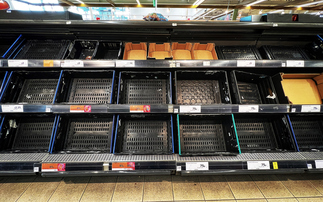Experts gathered this week at BusinessGreen's Leaders Forum event in London to discuss key strategies for unearthing and addressing environmental issues buried deep in supply chains
Across India, cotton fields have been transformed into baked earth plains as the country endures one of the worst droughts in its history. Meanwhile, in Southern Africa, a strong El Nino has caused the lowest levels of recorded rainfall in decades, spelling disaster for small communities struggling to keep crops and livestock alive. Even in the UK, farmers are on standby to make sure their newborn lambs withstand this week's unseasonable snowfall, which has blanketed parts of northern England and Scotland.
As extreme weather events become more frequent and more severe, the risks to supply chains around the world grow ever greater. Meanwhile, rising demand for land, water, and energy from a growing middle class population is adding further pressure to resource supplies, and post-Paris the growing likelihood of new emissions regulations and increased scrutiny of corporate behaviour adds another dimension to the supply chain puzzle.
Against this backdrop, experts from some of the world's leading brands, consultancies and NGOs gathered at BusinessGreen's inaugural Leaders Forum in London this week to discuss the most effective strategies for managing supply chain and resource risk - and how to transform this risk into an opportunity.
One of the key strategies speakers were keen to highlight was the role of strong procurement policies to drive change in supplier behaviour and embed responsible sourcing policies internally. Dexter Galvin, head of the CDP's supply chain programme, labelled procurement "the most effective lever" in driving change in the supply chain - a point which Peter Aldous, Conservative MP for Waveny and co-chair of the All-Party Parliamentary Sustainable Resource Group, echoed in his call for sustainable procurement to be embedded across all government departments.
The Crown Estate provided a compelling example of how a strong, sustainable procurement policy can transform a company culture, and the behaviour of suppliers. The property giant and asset manager for the UK's seabeds has just rewritten its procurement policy so that it now has sustainability "written all over it", according to head of sustainability Claudine Blamey. She said the firm now gives contractors clear tools and targets to eliminate as much waste and emissions as possible from its supply chain. For example, Blamey described how the firm now invests in buildings that can be "dismantled" rather than demolished at the end of their useful life, slashing waste levels.
Meanwhile, Paul Taylor, senior manager of environmental sustainability at the LEGO Group, explained how the toymaker has working with suppliers to develop innovative greener products and materials via a series of strategic risk management meetings with core suppliers. The meetings have sustainability as a permanent item on the agenda - a move that helps to make clear that sustainability is a "conversation that's had regularly, and they see that it's important to us and it's not going away really makes sure that we get traction," he explained.
Delegates also flagged targets as an essential tool for driving environmental improvements across the supply chain. "We've seen that our member companies which have a clear target for their supply chain emissions reductions, then correlates very clearly into much better performance in the supply chain," noted CDP's Galvin.
And as more and more companies begin to set targets for supply chain carbon reductions - driven in part by the continuing pressure on firms to crack down on emissions in light of the Paris Agreement - suppliers will be given less wiggle room, he predicted. "As more members have clear targets for their supply chain, then they will get less and less tolerant of suppliers that aren't adhering to their requirements," he predicted.
L'Oréal, for example, has just made a commitment that its top 300 suppliers will have a carbon reduction target in place by 2020 - and has made clear it isn't afraid to deselect suppliers who don't perform.
Drinks giant Diageo is also enthusiastic about the power of targets. "We love targets," declared Michael Alexander, head of water, agriculture and environmental sustainability at the company. "We love KPI's, we love data... That's the modern way of businesses, and that's the modern way of particularly consumer goods companies with complex supply chains."
Yet alongside implementing strict supplier standards, delegates also spoke of the innovation and creativity that can emerge when suppliers are afforded freedom to develop their own solutions to sustainability challenges.
Alexander explained that although Diageo operates a tight ship with its centralised targets, suppliers in its global markets can choose how to best achieve them. "We're a decentralised business," he said. "[Our suppliers] will adjust the model, they will adjust the approach, but they've got the targets to meet centrally," he explained.
Similarly, LEGO's Taylor revealed how he has used the brand's internal innovation platform - 'Inside Ideas' - to leverage supplier engagement. Normally, Inside Ideas can only be accessed by LEGO employees, where they use the platform to post and debate new ideas for the business. Taylor opened the platform up to 30 key LEGO suppliers to allow them to post ideas on how to improve the company's supply chain, resulting in workable proposals for making waste, transport and printing services more efficient.
Meanwhile, Aleyn Smith-Gillespie, associate director for business services
at The Carbon Trust, which has today published a new report on supply chain transformation and resource efficiency, said firms such as GlaxoSmithKline are also harnessing supplier innovation to tackle environmental challenges. The pharmaceutical firm's Supplier Exchange platform is a forum allowing more than 500 suppliers to share knowledge, best practices, and data. "One of the things we discovered through this process was that a lot of suppliers had a tremendous number of ideas for energy efficiency in their own operations," Smith-Gillespie said.
Supply chains are a source of significant corporate risk, both now and in the future. But if managed effectively, they are also a source of clear opportunity. To cite just one statistic, last year suppliers analysed by CDP reported $6.6bn of savings from emissions reductions activity.
Tackling the environmental impact of supply chains is perhaps one of the toughest challenges facing sustainability executives. But it seems that there are clear wins to be had through implementing strong procurement policies and ambitious targets - while allowing suppliers the freedom to innovate and come up with their own solutions to tricky challenges. And those companies that tackle the supply chain puzzle head-on will boost their resilience, burnish their environmental credentials, and cut their risk profile for decades to come.









